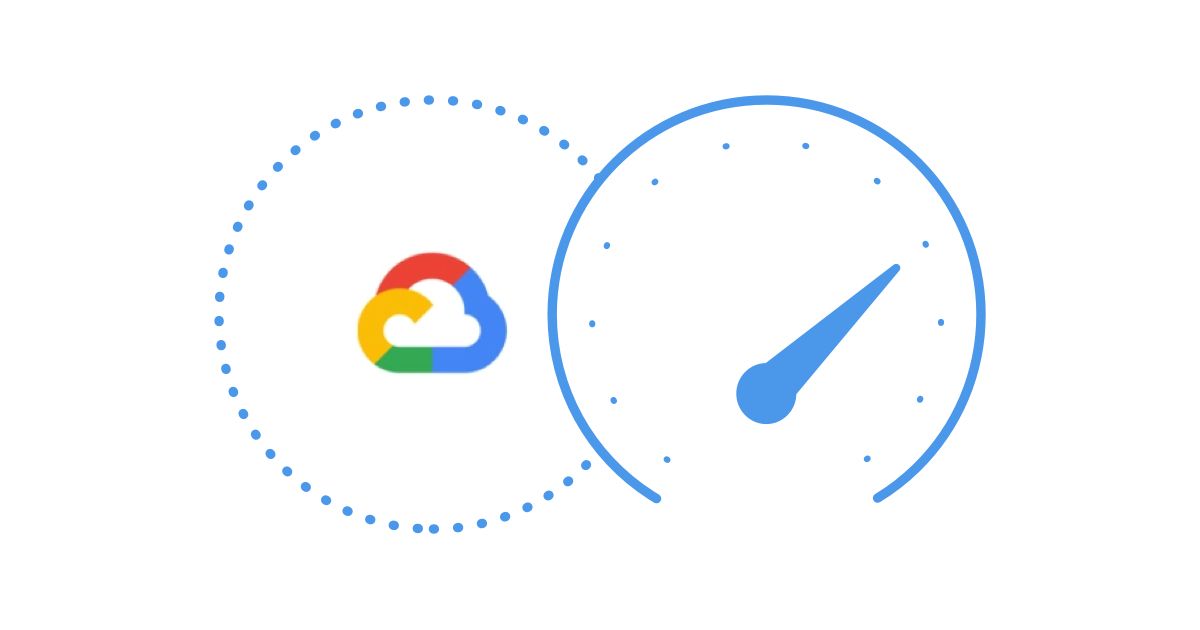Table of Contents
Table of Contents
Welcome to the cloud! As businesses and organizations continue to adopt cloud computing, the need for reliable and secure connectivity has become increasingly important. That's where AWS Direct Connect monitoring comes in, allowing you to establish a private, high-speed connection between your on-premises data center and your AWS cloud resources.
But, as with any network connection, there are bound to be performance issues and configuration challenges along the way. Fear not, my fellow cloud enthusiasts! In this fun guide, we'll navigate the murky waters of AWS Direct Connect monitoring, helping you optimize network performance, monitor AWS Direct Connect and AWS Site-to-Site VPN performance like a pro.
Continuous AWS Direct Connect monitoring is your key to ensuring the best AWS Direct Connect performance. From detecting outages, to identifying and troubleshooting AWS network issues, we're teaching you how to do it all in minutes using Obkio Network Performance Monitoring!
Whether you're a seasoned cloud veteran or a newbie, there's something here for everyone.
AWS Direct Connect is a network service provided by Amazon Web Services (AWS) that enables customers to establish a private, dedicated network connection from their on-premises data centers or office locations to AWS cloud services. This private connection can bypass the public internet, providing a more secure, reliable, and consistent network experience.
With AWS Direct Connect, customers can establish one or more dedicated network connections, each with a capacity of up to 100 Gbps, to any AWS region or service such as Amazon EC2, Amazon S3, and Amazon VPC. This allows for faster data transfer, lower latencies, and reduced network costs compared to using the public internet.
In addition, AWS Direct Connect provides access to AWS services in a more secure manner, by establishing a private virtual interface that does not traverse the public internet, making it ideal for organizations with strict security and compliance requirements.
AWS Customers use the AWS service to connect their on-premise infrastructure with their infrastructure hosted in AWS Cloud. With AWS Direct Connect, customers can privately communicate with their EC2 instances and other services located in private VPC Subnets. This can also be done with AWS Site-to-Site VPN but without the benefit of the cost reduction and enhanced network performance that AWS Direct Connect can offer.
Today, we will explain why and how to monitor the network performance of AWS Direct Connect between on-premise infrastructure up to the AWS Cloud. You can follow the exact same steps to do it with the AWS Site-to-Site VPN configuration.


You probably already have some kind of monitoring system that probes your devices and alerts you if the device is down or if the CPU is too high. That's a good thing and you should keep it.
However, what happens if your provider has some kind of issues such as network congestion that causes packet drops? The sooner you know, the faster you can start working on fixing the issue, therefore reducing the time it affects your customers or end-users.
Without a good AWS network monitoring tool, you just keep experiencing intermittent issues you don't really understand and can't measure. Measuring things is the first step to making them better.
- Optimize Network Performance: AWS Direct Connect monitoring can help identify network performance issues such as packet loss, latency, and jitter. This information can help organizations optimize their network configuration, troubleshoot issues, and ensure their applications and services are running smoothly.
- Identifying AWS Network Issues: By monitoring AWS Direct Connect, organizations can quickly identify and diagnose network issues happening in the AWS network, such as dropped connections, misconfigured network devices, or other issues that may impact network performance. This can help organizations proactively address issues and minimize downtime or service disruptions.
- Improve End-User Experience: Identifying and solving network issues affecting AWS Direct Connect performance can help organizations proactively address issues and minimize downtime or service disruptions, leading to a better user experience.
- Cost Optimization: AWS Direct Connect billing is based on the amount of data transferred over the connection, so monitoring data transfer rates can help organizations optimize their network utilization and reduce their network costs, ultimately improving the overall user experience.
- Capacity Planning: As organizations grow and their network demands increase, they may need to upgrade their AWS Direct Connect connection to accommodate additional traffic. Monitoring the connection can help organizations plan for capacity upgrades and ensure that they have the necessary bandwidth to support their business needs and maintain a positive end-user experience.
Now we're going to show you how to set up your very own AWS Direct Connect monitoring using Obkio. It's smooth sailing from here, as the setup takes only a few minutes and allows you to chart the course of your AWS Direct Connect performance on an ongoing basis.
With Obkio as your trusty compass and network connection monitoring soldier, you'll always know the status of your network connection and be able to navigate the cloud with ease!
If you want to take the hassle out of monitoring your AWS Direct Connect performance, we recommend using a tool like Obkio Network Performance Monitoring. This trusty tool does the heavy lifting for you, continuously monitoring end-to-end network performance and identifying AWS network issues.
With Obkio's Cloud network monitoring features, you can rest easy knowing you have your very own AWS network monitor. So sit back, relax, and let Obkio be your guide through the cloud!

When you're monitoring network performance, whether that's WAN, LAN, or network devices, you need to ensure that you're monitoring every part of your network. You need to make sure you're keeping a watchful eye on every part of your network just like a seasoned sailor charts their course to avoid hazards in the sea!
That's where the Network Monitoring Agents come in. Obkio's Monitoring Agents are deployed at key network locations to continuously monitor performance between them.
When you're deploying your AWS Direct Connect monitoring setup, we want to monitor the network performance between the AWS Cloud and the on-premise infrastructure. To do, you'll need to deploy two Monitoring Agents (at the very least):
- AWS Cloud Agent: The AWS Monitoring Agent is hosted and maintained by Obkio in the AWS cloud infrastructure. It allows you to proactively monitor network performance between your local network to the Amazon Web Services network. They provide complete and continuous visibility so you can easily identify the source and cause of AWS network issues affecting your network performance and AWS Direct Connect performance.
- On-Premise Agent: These Monitoring Agents are deployed in your local network, in key network locations like your head office, branch office, data centers and network devices. They allow you to monitor network performance from your end. We recommend the Software (Linux, Windows, Docker) agent that can be installed on your favorite Linux distribution, including Amazon Linux and Amazon Linux 2.
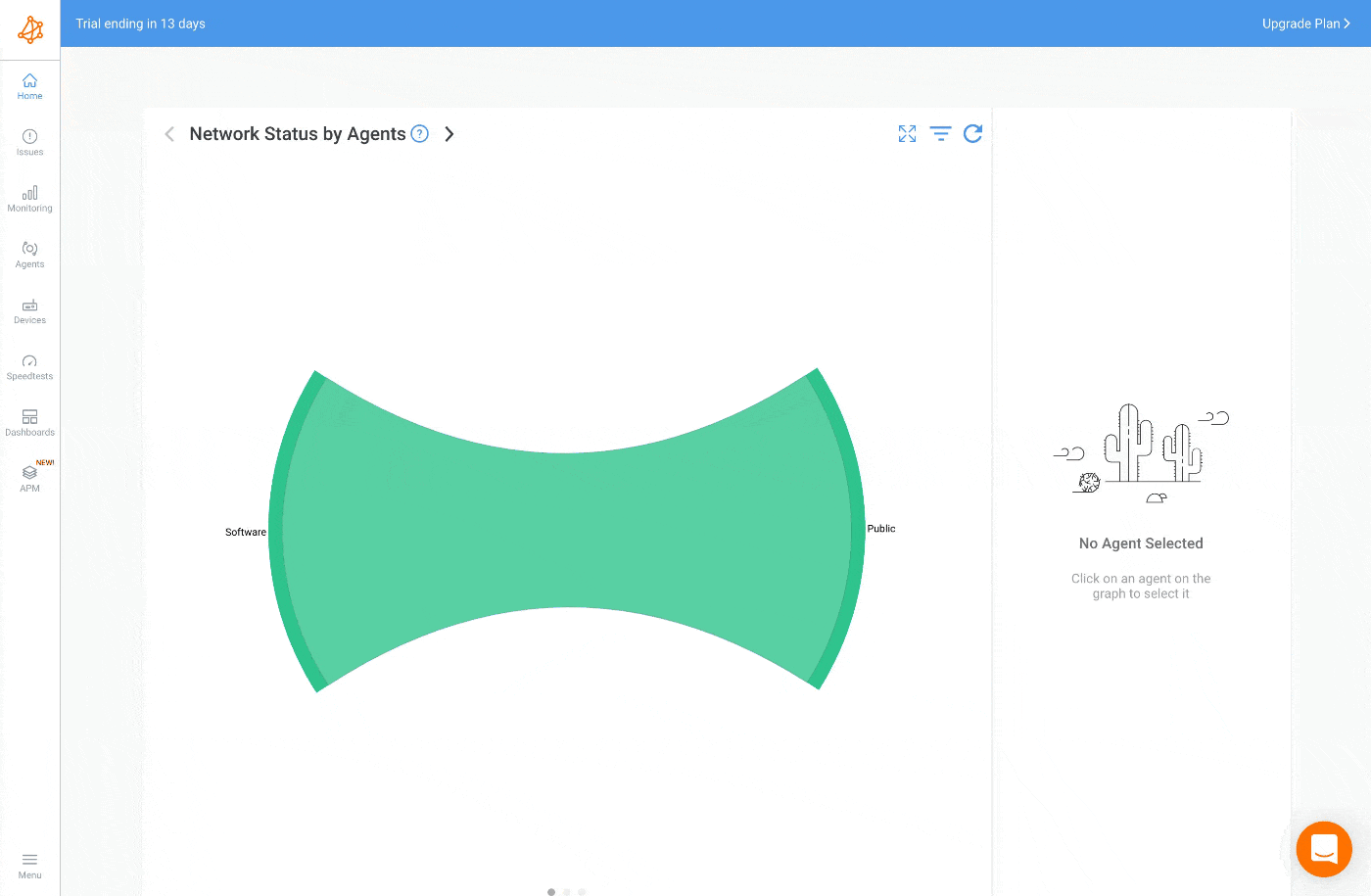
P.S. You can also use the AWS Monitoring Agent to monitor Zoom performance.
Once the Monitoring Agents are installed, you're almost done! There are two configurations that are required in the App:
- The agents must be in the same Network. When two agents are in the same Network, they will communicate using private IPs instead of Public IPs.
- A Network Monitoring Template must be configured to create the network performance monitoring session.
Once the Monitoring Agents are deployed and configured, they will begin exchanging synthetic UDP traffic and continuously measure network and AWS performance. This is where the fun happens!
That's it! It's as simple as that. Now, the agents will send packets to each other every 500ms to measure AWS Direct Connect metrics and network metrics to give you an overview of your network performance, and identify any issues affecting your AWS Direct Connect service.
There are several important network metrics that should be monitored for AWS Direct Connect to ensure optimal performance. Here are some of the key metrics to monitor:
- Bandwidth Utilization: This metric indicates the amount of network bandwidth being used over time. Monitoring bandwidth utilization can help identify trends, peak usage times, and potential capacity issues that may impact network performance.
- Latency: The latency metric measures the time it takes for data to travel from one point to another over the network. High latency can indicate network congestion, misconfigured network devices, or other issues that may impact network performance.
- Packet Loss: The packet loss metric measures the percentage of packets that are lost or dropped during transmission. High packet loss can indicate network congestion or misconfigured network devices, which can impact network performance.
- Jitter: The jitter metric measures the variability in packet delay. High jitter can cause delays in packet delivery, resulting in poor network performance.
- Network Error Rates: The network error rate metric measures the number of errors that occur during data transmission. High error rates can indicate issues with network devices, cabling, or other network components that may impact network performance.
- Network Availability: The network availability metric measures the percentage of time that the network connection is available and operational. Monitoring availability can help identify downtime or service disruptions that may impact network performance.
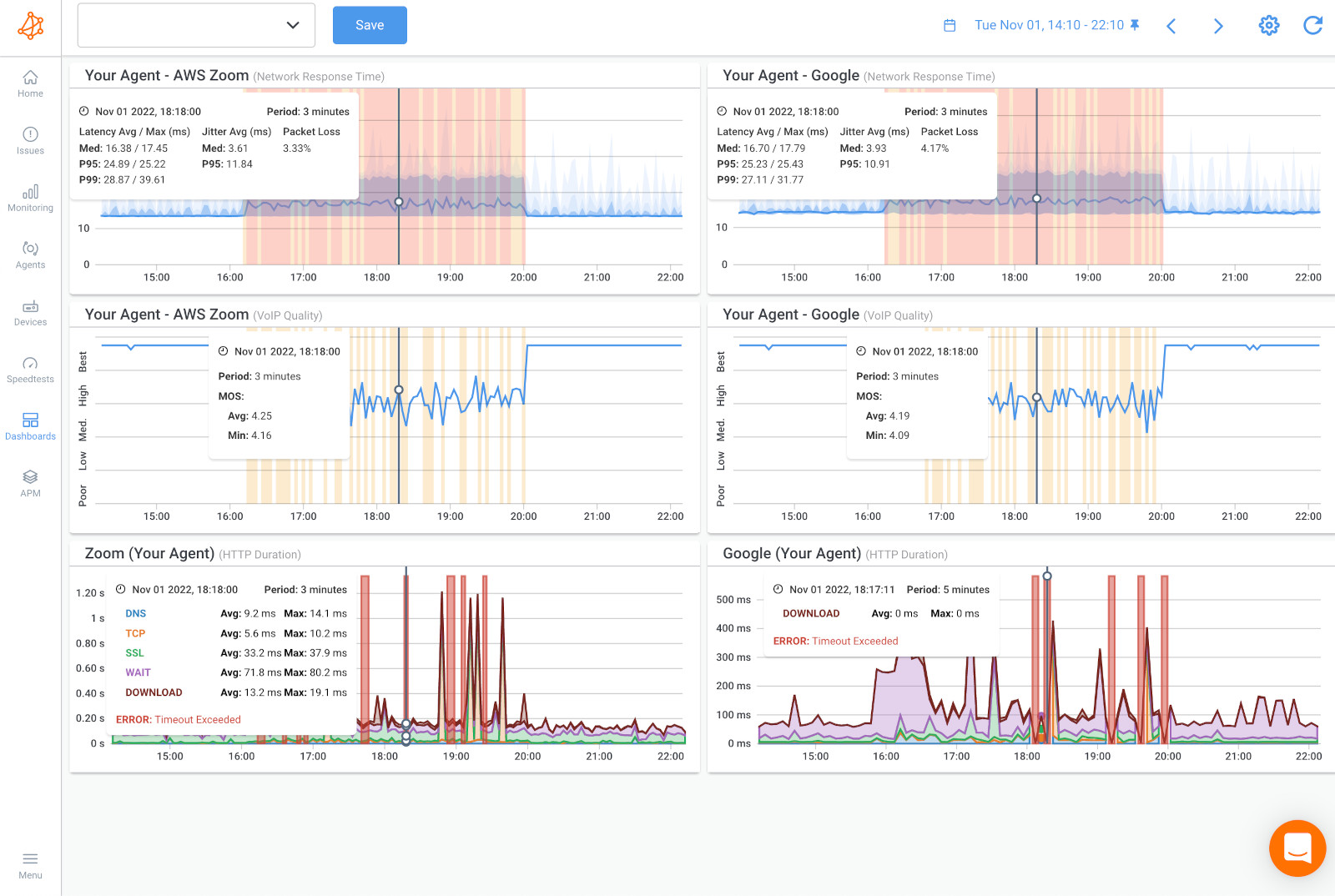
By monitoring these key network metrics, organizations can gain insight into their AWS Direct Connect performance, identify potential issues, and optimize network configuration to ensure optimal performance. Obkio can help automate the monitoring process and provide detailed metrics and insights into network performance.
Monitoring network devices is also extremely important for AWS Direct Connect monitoring. Network devices such as routers, switches, and firewalls play a critical role in network connectivity and can impact AWS Direct Connect performance.
Luckily, Obkio's Network Device Monitoring feature is here to help! Obkio’s Network Device Monitoring features uses Ultra-Fast Polling (every 30 seconds) to monitor your network devices and provide results that are far more precise than the traditional software polling, which occurs every 5 minutes.
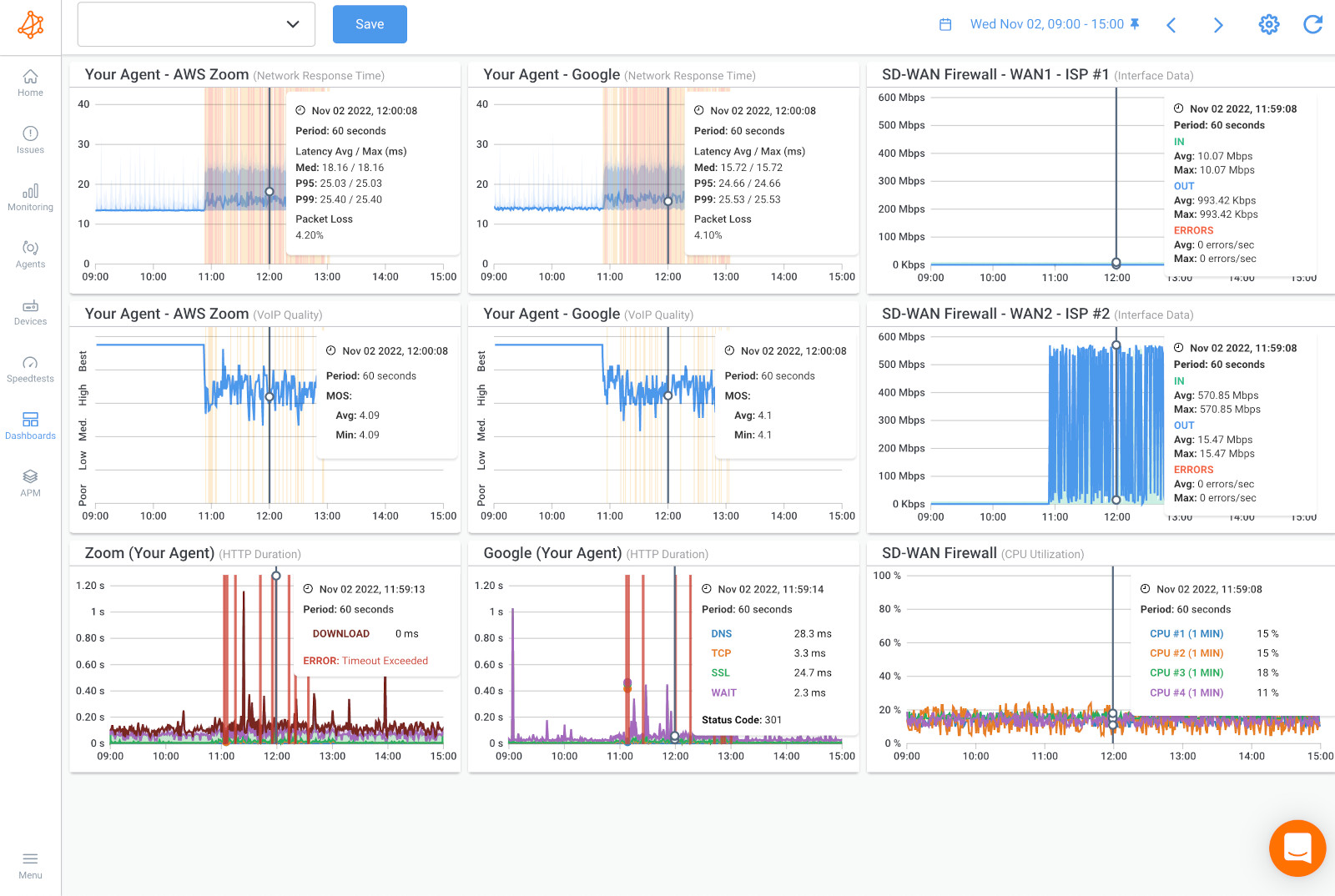
Monitoring network devices can help identify potential issues such as misconfigured devices, high CPU or memory usage, or hardware failures that can cause network connectivity issues or impact network performance.
In addition, monitoring network devices can also help with network capacity planning and network optimization. By analyzing device metrics such as interface utilization, errors, and discards, organizations can identify potential bottlenecks and proactively make configuration changes or hardware upgrades to optimize network performance.
Overall, monitoring network devices is a critical component of AWS Direct Connect monitoring, and can help organizations ensure optimal network performance and connectivity.

Now that you've started monitoring, it's time to collect some results!
With continuous AWS Direct Connect monitoring, you can detect AWS and network outages within 5 seconds and network performance degradation or AWS network issues within 1 minute! You can also go back in time and see the exact network performance for every minute of the previous week.
- Obkio's Traceroutes are also executed periodically in both directions to identify hop-by-hop issues and to keep track of the historical latency between hops.
- Schedule Speedtests between the agents to monitor network speed and test the available throughput on the connection between the on-premise infrastructure and the AWS Cloud.
With all these features, it'll be much easier to identify and troubleshoot network issues. But what are some of the most common network issues affecting AWS Direct Connect? Let's go through them:
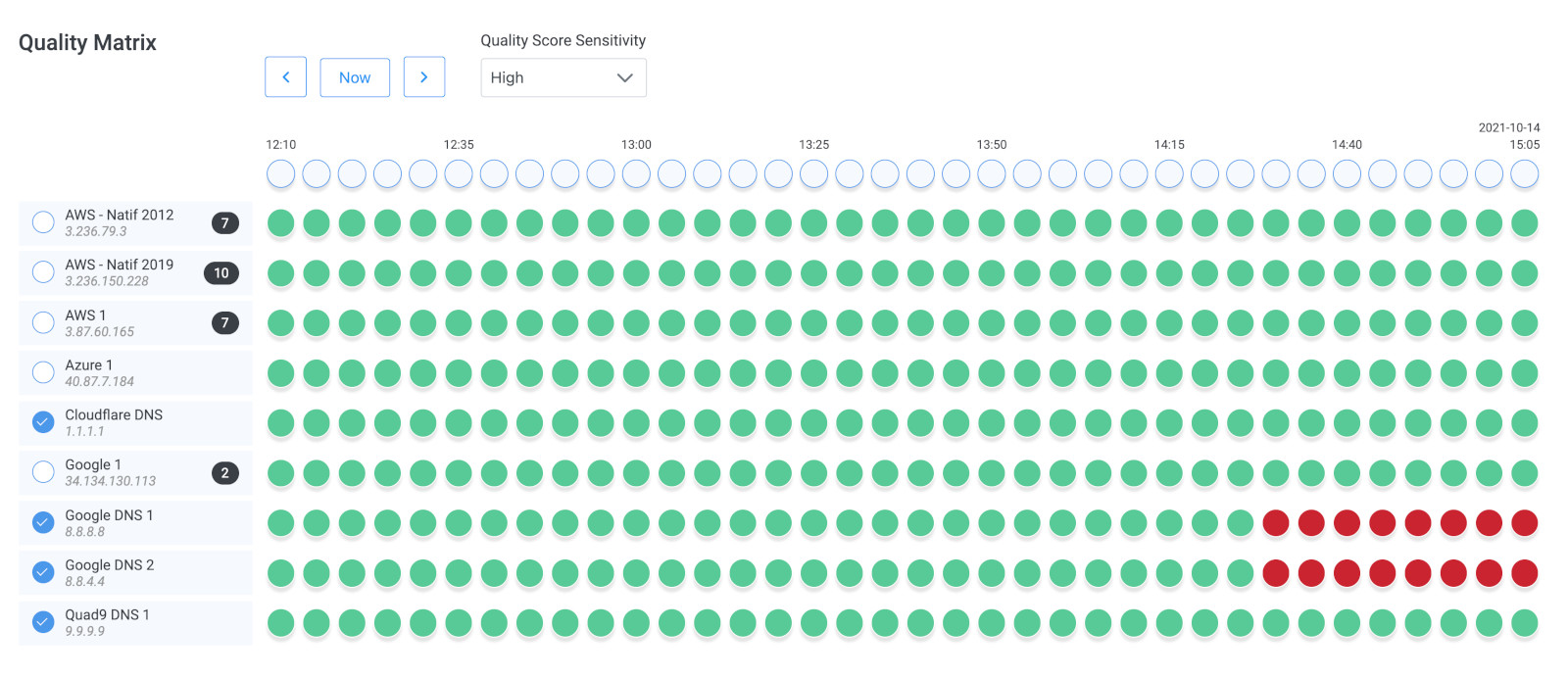
There are various network problems that can impact AWS Direct Connect performance. Here are some of the common network issues to watch out for:
- Network Congestion: This occurs when there is excessive traffic on the network, causing delays in data transmission and higher latency. Network congestion can lead to decreased bandwidth and slower network performance.
- Misconfigured Network Devices: Misconfigured network devices like routers and switches can cause routing issues, packet loss, and higher latency. These issues can impact network performance and cause connectivity problems.
- Physical Network Issues: Physical network issues like damaged cables, loose connectors, or faulty network devices can lead to packet loss, higher latency, and decreased network performance.
- AWS Service Disruptions: AWS Direct Connect can experience service disruptions or outages, which can impact network performance and cause connectivity problems.
- Network Security Issues: Network security issues like DDoS attacks or other malicious activity can impact AWS Direct Connect performance, causing latency or packet loss.
By monitoring key network metrics and keeping a watchful eye out for these common network issues, organizations can help ensure optimal AWS Direct Connect performance. Obkio can help automate the monitoring process and provide real-time alerts and detailed metrics to help organizations quickly identify and resolve network issues.
With this AWS Direct Connect monitoring setup, you'll have all the information you need to troubleshoot network issues affecting AWS Direct Connect, and take steps to optimize performance.
Here are some ways to optimize AWS Direct Connect performance:
- Continuous Network Performance Monitoring: Of course, the continuous monitoring of network performance is critical for optimizing AWS Direct Connect performance. This includes monitoring network devices, tracking network metrics like latency, packet loss, and bandwidth utilization, and proactively identifying and resolving issues. Obkio can help track network metrics and provide real-time network monitoring alerts when issues arise.
- Proper Network Planning: Proper network planning is critical to ensure optimal AWS Direct Connect performance. This includes selecting the right Direct Connect location, proper capacity planning, and configuring the network for redundancy.
- Optimize Network Devices: Network devices like routers and switches should be optimized for AWS Direct Connect traffic. This includes configuring QoS policies, optimizing MTU size, and enabling ECMP for redundancy.
- Utilize AWS Direct Connect Gateway: AWS Direct Connect Gateway is a service that allows you to connect multiple VPCs to a single Direct Connect connection. This can help optimize traffic routing and reduce data transfer costs.
- Check Security Groups: AWS security groups control inbound and outbound traffic to EC2 instances and other AWS resources. Misconfigured security groups can cause connectivity issues and impact network performance.
- Test Network Connectivity: Performing network connectivity tests can help identify issues with network routing, packet loss, or latency. You can use Obkio Vision, a Free Visual Traceroute tool to test network connectivity.
By following these tips and leveraging Obkio's network monitoring and troubleshooting tools, organizations can quickly identify and resolve AWS network issues, ensuring optimal network performance and connectivity.

As we said earlier, you can use these same steps to monitor AWS Site-to-Site VPN performance.
AWS Site-to-Site VPN is a service provided by Amazon Web Services (AWS) that enables customers to establish secure and encrypted IPsec VPN connections between their on-premises data centers or office locations and their Amazon Virtual Private Cloud (VPC) environments in the AWS cloud.
With AWS Site-to-Site VPN, customers can extend their on-premises network to the AWS cloud, allowing them to securely access and manage their cloud resources as if they were on their own network. This is achieved by establishing a secure tunnel between the customer's on-premises VPN device and the AWS VPN Gateway.
AWS Site-to-Site VPN supports both static and dynamic routing options, allowing customers to choose the routing protocol that best fits their needs. It also supports the use of multiple VPN connections for high availability and increased bandwidth.
You can monitor AWS Site-to-Site VPN with Obkio's network performance monitoring tool by deploying a Network Monitoring Agent on both ends of the VPN connection. The Monitoring Agent will continuously monitor the key metrics of the VPN connection, including latency, bandwidth utilization, packet loss, and VPN tunnel status.
Here's a step-by-step guide to monitoring AWS Site-to-Site VPN with Obkio:
- Choose A Network Monitoring Tool: Select a network monitoring tool that offers AWS Site-to-Site VPN monitoring capabilities. Obkio's NPM tool can help you monitor the performance of your AWS Site-to-Site VPN connection.
- Install the Network Monitoring Agent: Install the network monitoring agent on both ends of the VPN connection. The agent will capture and analyze network traffic data in real-time.
- Monitor AWS Site-to-Site VPN Metrics: Monitor the key metrics of the VPN connection, including latency, bandwidth utilization, packet loss, and VPN tunnel status.
- View Real-Time Data: Once Obkio is configured, you can view real-time data on the performance of your AWS Site-to-Site VPN connection. This data will help you identify any issues and troubleshoot them quickly.
By monitoring your AWS Site-to-Site VPN connection using Obkio, you can gain insights into the performance of your VPN connection and proactively identify and troubleshoot issues.


You can monitor AWS Site-to-Site VPN performance using network monitoring tools by tracking the following key metrics:
- Latency: Monitor the time it takes for data to travel between the on-premises network and the AWS cloud. Latency can have a significant impact on application performance and end-user experience.
- Bandwidth Utilization: Monitor the amount of bandwidth being used by the VPN connection. Tracking bandwidth utilization can help identify potential network congestion issues and capacity constraints.
- Packet Loss: Monitor the number of packets lost during transmission over the VPN connection. High packet loss rates can impact application performance and lead to poor user experience.
- VPN Tunnel Status: Monitor the status of the VPN tunnel and track any changes in the tunnel status. Changes in the tunnel status can indicate connectivity issues or potential security threats.
By monitoring these key metrics using network monitoring tools like Obkio, you can gain real-time visibility into the performance of your AWS Site-to-Site VPN connection and quickly identify and troubleshoot any issues that may arise.
In conclusion, navigating the cloud and managing your AWS Direct Connect network doesn't have to be a daunting task. By following these best practices and using monitoring and troubleshooting tools like Obkio, you can easily monitor your network performance, identify network issues, and optimize your AWS Direct Connect connection for optimal performance.
Now that you have the monitoring setup in place, it is very easy to install more agents in branch offices, datacenters and other clouds providers to monitor network performance. There are also Public Monitoring Agents available to monitor performance to your favorite service provider on the Internet.
You can also learn how to use Obkio's AWS Agent to monitor the performance of Amazon Chime, or other unified communication applications in our UC Monitoring collection.
So go ahead and navigate the cloud with confidence, knowing that you have the right tools and knowledge to tackle any AWS Direct Connect challenge that comes your way!

Are you prepared to optimize your network and Cloud performance to new heights? Don't let anything hold you back from achieving network excellence - sign up for Obkio's network performance monitoring tool now and let Obkio guide you towards optimized AWS Direct Connect network performance.
- 14-day free trial of all premium features
- Deploy in just 10 minutes
- Monitor performance in all key network locations
- Measure real-time network metrics
- Identify and troubleshoot live network problems



























 Obkio Blog
Obkio Blog





